Chapter 7 : Water Regime
- 7.1 Introduction
- 7.2 Reservoir Water Levels Relative to Flood Pulse Concept
- 7.3 Effects of Water Regime
- 7.4 Water Regime Management
7.1 Introduction
Water regime, which includes water-level fluctuations and water retention, is an important characteristic of reservoir environments. Water-level fluctuations can be large (Figure 7.1) and fluctuation patterns influence physical, chemical, and biological features of reservoirs, especially in shallow reservoirs and nearshore zones of all reservoirs because these are exceptionally sensitive to changes in water level. Aquatic habitats and feeding and spawning grounds are gained and lost as water levels fluctuate. The littoral zone is the most likely habitat to be affected by reservoir water-level fluctuations, which affect some fundamental processes, such as decomposition, production, and trophic interactions among organisms. Similarly, a diversity of water retention rates makes reservoirs range in characteristics from river-like to lake-like. Therefore, water regime may have an overriding effect on the ecology, functioning, and management of reservoirs.
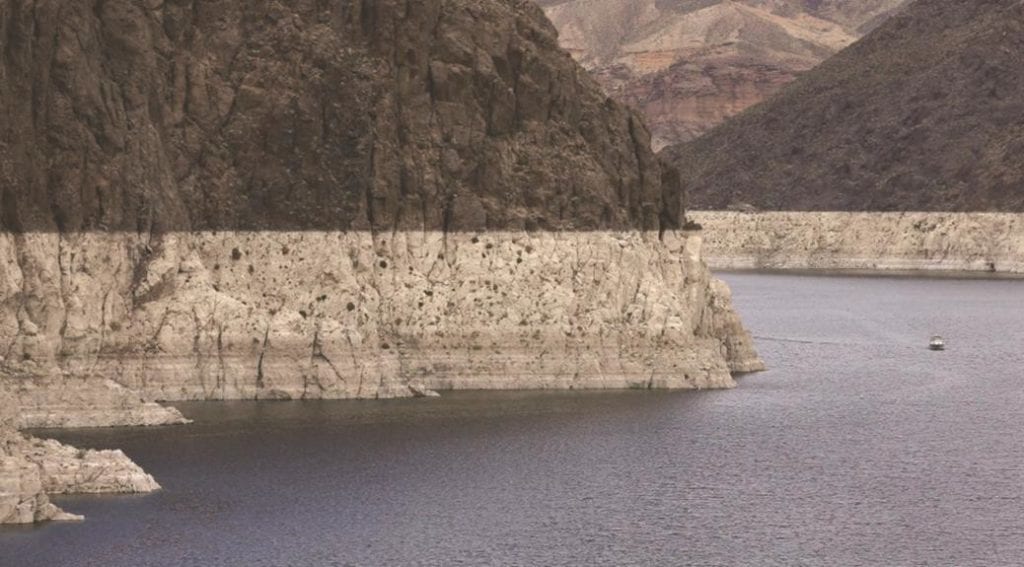
Reservoirs are engineered to meet well-defined operational goals. Several important physical attributes, including depth, area, and flushing rate, are dictated by reservoir location, topography, and hydrology. These attributes are controlled further by structural (e.g., dam height, outlet depth) and operational (e.g., water-level targets, release rates) characteristics. Operation of reservoirs generally is constrained by existing legalities in project authorizations, water control goals, and local physiographic and climatological features.
Operational goals of a reservoir dictate water regime (Kennedy 1999). Navigation uses, which usually occur in shallow channels, require that reservoirs be maintained near 100% of their storage capacity, thus water-level fluctuations are generally small. Hydropower reservoirs are deeper so that they can attain efficient hydraulic head. They usually exhibit diel fluctuation patterns associated with intermittent water releases to generate electricity, annual fluctuation patterns associated with precipitation cycles, and, in some areas, multiyear cycles associated with long-term drought. Although there is great variability, water level in reservoirs whose main purpose is water supply for agriculture often varies on a scale of several years, as the reservoir may be used to store water during wet years to compensate for dry years. Conversely, flood control reservoirs can experience seasonal drawdowns to <30% of capacity be- cause of their requirement to store seasonally excessive runoff. Water levels in flood control reservoirs generally follow marked annual patterns.
As much as possible, notwithstanding the vagaries of rainfall, reservoir operators follow pre-established guide curves, which dictate what the water level should be on each day of the year (Figure 7.2). Guide curves are formal (often legal) descriptions of where the water level should be on any given day of the year to meet the reservoir’s primary purposes (e.g., flood control, power generation, navigation) within the constraints posed by droughts, floods, and other unforeseen circumstances (see sections 7.4.8-7.4.10). Regional authorities or regulatory agencies develop guide curves to optimize water storage benefits among reservoirs in a river basin. For instance, the Tennessee Valley Authority manages 41 reservoirs on the main-stem Tennessee River and its numerous tributaries, and the operation of each dam affects the operation of other dams in that system.
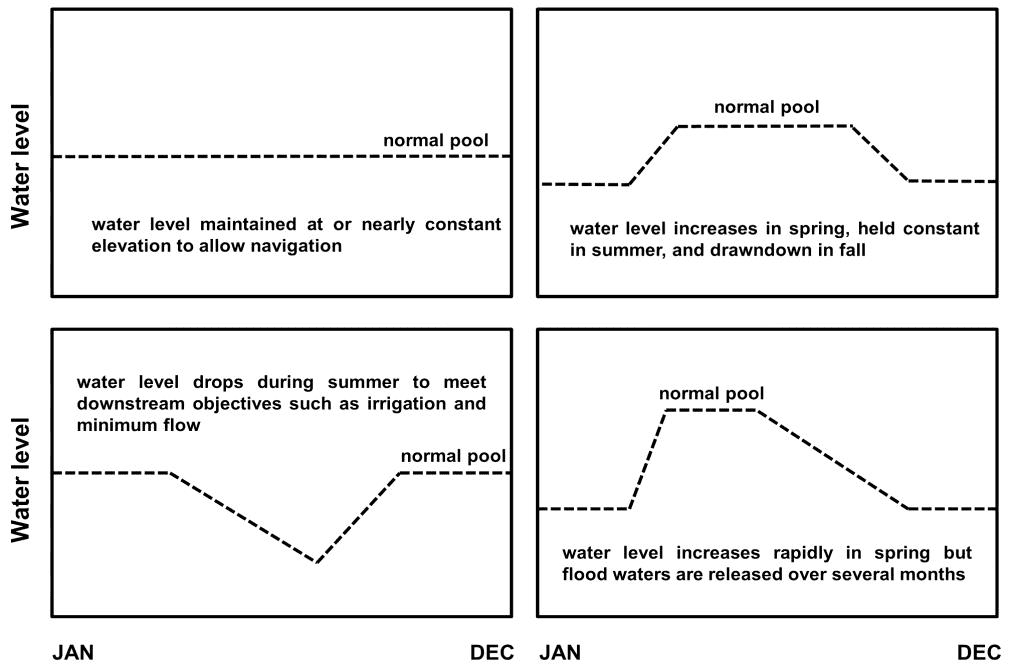
Hydraulic retention time influences various abiotic and biotic characteristics of reservoirs—in particular, primary production. Retention time can range from a few days to a few years (Søballe and Kimmel 1987) and tends to be lower in reservoirs low in a river basin than those high in the basin (Miranda et al. 2008). Phytoplankton communities reach their full production potential in reservoirs with high retention times, which behave more like lakes and less like rivers. In a study of reservoirs across the USA, Søballe and Kimmel (1987) noted that algal communities needed about 60–100 d of retention time to realize their full potential at any given level of nutrients. In Alabama reservoirs, the relationship between retention time and algal production was confirmed, but the threshold retention time was thought to be closer to 30 d (Maceina et al. 1996). The retention time in any reservoir is driven by storage capacity and the amount of precipitation in the watershed, which varies seasonally and annually. Thus, retention time and primary production varies within and between years. In hypereutrophic reservoirs, long retention times can be problematic as they may foster cyanobacteria blooms that can cause human and animal health concerns and limit fish production (section 4).
7.2 Reservoir Water Levels Relative to Flood Pulse Concept
Inundated floodplains in river systems contribute habitats that provide fish space for reproduction, feeding, and refuge (Junk et al. 1989; Bayley 1995). When waters recede, wetland and upland vegetation thrive (Casanova and Brock 2000; Leyer 2005), rejuvenating the floodplain until the next flood pulse. This effect is particularly evident in large lowland rivers where floodplains are sizeable and make up a large part of the river ecosystem (Tabacchi et al. 1998; Kingsford 2000). As a consequence, fish communities in large rivers frequently exhibit high biodiversity, attributed to the structural diversity and habitat richness of floodplain environments (Schiemer 2000).
Similarly, reservoirs that experience water-level fluctuations as part of their operational objective periodically inundate and dewater nearshore areas. However, nearshore areas in reservoirs are different from river floodplains. Within the main stem and throughout most embayments, water levels fluctuate over elevation contours that were once uplands. These uplands have slopes, soils, and seed banks that are different from those of floodplains. A true floodplain does not occur in reservoirs except in the upper reaches where tributaries enter the reservoir. Size of floodplains in reservoirs is usually small in small tributaries and in reservoirs high in a river basin; conversely, floodplains are usually large in large tributaries and in reservoirs impounded over lowland rivers.
7.3 Effects of Water Regime
The effects of water-level fluctuations on nearshore reservoir environment are influenced by the amplitude, frequency, periodicity, and timing of the fluctuations (Ploskey 1986). The effect of water-level fluctuations may be expected to be directly related to the amplitude of the fluctuations, as large fluctuations are likely to affect a larger portion of the nearshore zone. The frequency of fluctuation determines the duration of the effect (exposure or inundation) and the time available for the responses of the biota. The effect of reservoir drawdown may be either beneficial or detrimental to the littoral ecosystem depending on the duration of the drawdown (Godshalk and Barko 1988). The frequency of fluctuations may vary from diel (e.g., pump storage, hydropower reservoirs), to seasonal (flood control), to long-term (irrigation) fluctuations. Timing of water-level fluctuations can promote habitat integrity, encourage or suppress plant growth, and stimulate fish access to key habitats during critical periods of their life cycle (Miranda et al. 2014).
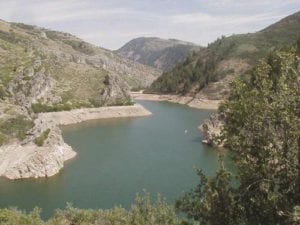
Utah, showing a bare band in the regulated zone. Photo credit: Utah Division of Wildlife Resources, Salt Lake City.
Water retention time influences several water-quality constituents directly and many more indirectly (Søballe and Kimmel 1987; Straškraba 1999). Temperature, dissolved oxygen, and the production of algae are affected directly by water retention time (sections 4 and 6). The timing and degree of thermal stratification (the separation or layering of colder and warmer waters within the reservoirs) also is related directly to water retention time. Dissolved oxygen concentrations in reservoirs are related to thermal stratification, oxygen demand (biological, chemical, and sediment), and the timing and depth of water releases. Water retention time and the availability of nutrients and light affect the dynamics of phytoplankton growth. In turn, phytoplankton play a critical role in the dissolved oxygen balance of the system. Water retention time changes seasonally and is usually higher in summer and early fall, although this varies geographically.
A survey of reservoir managers identified that approximately 12% of reservoirs ≥250 ac in the USA had moderate-to-high or high complications associated with water retention time (Krogman and Miranda 2016). Quick flushing of the reservoir maintained high turbidity and precluded development of plankton communities. This percentage was as high as 22% in reservoirs managed for hydropower. In terms of water levels, seasonally mistimed water-level fluctuations were problematic in 16% of reservoirs. Timing of annual filling and emptying was inconsistent with the life-history requirements and habitat needs of fish. This percentage was as high as 27% in reservoirs managed for flood control and for irrigation.
7.3.1 Aesthetics
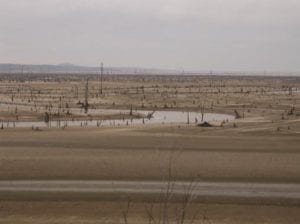
The exposure of nearshore substrates and stumps in reservoirs is the most visually obvious effect of water-level fluctuations, although the extent of the effect varies with slope of the reservoir basin (i.e., steepness of nearshore zone; Stamou et al. 2007). When the reservoir is near normal pool (Figure 7.2), the trees on the reservoir banks are seen as though emerging from the water, giving a pleasant aesthetic view. Progressive lowering of the water level results in the appearance of an area of barren, uncovered land (i.e., the regulated zone). The regulated zone interrupts the continuity of the landscape and gives the impression of an empty reservoir. In reservoirs where shore slopes are steep, regulated zones appear as bare bands (or rings; Figure 7.1 and 7.3). In reservoirs with mild shore slopes, regulated zones give the impression of desert areas, often called mudflats (Figure 7.4). The regulated zone tends to produce muddy water, large areas of exposed lake bottom, and eroding shoreline, which are primary detractors from scenic quality. Reservoir rings, mudflats, or exposed objects can detract from site attractiveness at low water levels.
7.3.2 Physiography
The extent to which flood pulses affect nearshore habitats depends on physiography. For example, in steep terrain such as mountain reservoirs, the nearshore area is only scarcely developed, and the surface affected by water-level fluctuations is small even during large fluctuations. Conversely, shallow reservoirs with low-gradient zones provide more space for flood expansion. Large, shallow reservoirs with a strong riverine influence will have sharper hydrographs than those fed mainly by surrounding runoff, minor tributaries, or diffuse inflow from groundwater. Thus, shallow systems with gradually sloping shorelines are more affected by water-level fluctuations than lakes with steep nearshore slopes because larger areas are flooded and exposed. In general, fluctuating water levels tend to produce straighter shorelines, gentler slopes, and softer homogeneous substrate.
7.3.3 Sediment
Sediment distribution and composition along the nearshore zone depends on water regime (Furey et al. 2004). The shore zone that is exposed to waves for the longest time of the year has the coarsest sediment, while the average grain size decreases with decreased wave exposure (i.e., downward on the depth gradient). During drawdown or rising water levels, the moving surf zone touches different types of sediment. Sediment at different depth zones may be chemically different, so that the surf zone mobilizes variable quantities and qualities of dissolved substances as water levels change (Figure 7.5).
During the rising water-level phase, several processes facilitate the deposition and temporal storage of organic matter in the nearshore zone of reservoirs. Apart from drowned terrestrial biomass, rising water collects the organic matter that has become deposited during a drought and carries it to the surf zone. This terrestrial leaf litter becomes degraded by waves and is then contributed to the nearshore zone as organic sediment.
7.3.4 Bottom Exposure
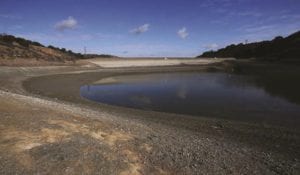
water levels at Stevens Creek Reservoir, California. Photo credit:
J. Sullivan, Getty Images.
Periodic long-term exposure of sediment by fluctuating water levels may consolidate flocculent sediment and potentially increase reservoir capacity. In experiments with sediment dredged from Lake Apopka, Florida, Fox et al. (1977) noted that dewatering and drying for various periods of time shrank bottom sediment. Also, water had the same or lower nutrient concentrations, reduced turbidity, and higher dissolved oxygen tensions after bottom exposure. Similarly, reduced water levels and concomitant compaction and aerobic decay of organic matter in Lake Tohopekaliga, Florida, reduced the depth of organic sediment by 50%–80% (Wegener and Williams 1974).
The positive benefits that a drawdown can have on sediment desiccation may result in some undesirable effects such as enhanced rates of nutrient release after refill (Fabre 1988). The outcome of enhanced rates of internal nutrient loading from consolidated sediment could be the development of a large pulse of nitrogen and phosphorus to the water column and stimulation of excessive algal growth. Positive and negative effects of sediment desiccation on macrophyte and phytoplankton growth need to be considered before implementing lake drawdown and refill as a management technique.
7.3.5 Erosion
A less obvious effect of water-level changes is shoreline alterations due to erosion and redeposition of sediment from nearshore substrates and shore banks (Figure 5.6). Waves driven principally by wind but also by navigation distribute sediment vertically along the nearshore zone according to particle sizes (Furey et al. 2004). Large rocks and gravel remain nearshore, whereas progressively smaller particles are displaced gradually toward deeper contours. Wind and rain also erode substrates exposed by drawdown.
The area modified by erosion is largely determined by the magnitude of water-level fluctuations and the morphometry of the reservoir. Rates of shoreline changes depend on characteristics of the fluctuation zone—its slope, degree of exposure, and composition (Gasith and Gafny 1990; Hofmann et al. 2008). When steep shores of impoundments are exposed to large fluctuations in water level, they generally erode rapidly and, depending on local geology, leave a zone of barren rock interspersed with gravel.
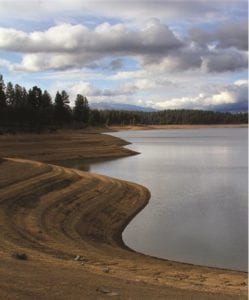
In contrast to the relatively permanent rapid changes in steep-sided impoundments, the shorelines of shallow reservoirs undergo slower long-term erosion (Reid 1993). Alluvial soils in these exposed, wind-swept, low-slope littorals are easily eroded. However, because of the gradual slope, erosion is slow and involves large areas even when vertical changes in water levels are small but especially when they are large. Rising turbid waters redeposit sediment at higher elevations to form terraces at various elevations that are dictated by the water levels (Figure 7.6).
Terrestrial vegetation that develops in dewatered areas helps attenuate the effects of erosion. Cleared areas of Beaver Reservoir, Arkansas, were subjected to greater and more rapid erosion than areas with vegetation (Aggus 1971). Breakup and decomposition of flooded herbaceous vegetation in Beaver Reservoir resulted in a conspicuous increase in erosion and redeposition. Erosion also was noticeably slowed in several Kansas reservoirs by flooded herbaceous vegetation established during drawdowns in the previous growing season (Groen and Schroeder 1978).
7.3.6 Ice Formation
Ice formation affects nearshore habitats, and the effect depends on water level (Reid 1993). When reservoirs freeze and undergo cold contraction, cracks are formed into which water flows and freezes. Subsequent warming will expand the ice, forcing the ice to buckle, and to be shoved onto the shores. Sediment in the nearshore can be moved shoreward by this force. By the time the reservoir freezes, the pool level often has dropped below bank levels, reducing direct impacts on the shoreline. However, many reservoirs freeze when the water level is high; thus weakening of the banks may occur, resulting in massive bank failures in the following spring and summer.
7.3.7 Water Clarity
Sources of colloidal turbidity in reservoirs include inflowing tributaries, erosion of banks and mudflats (via waves, wind, and rain), and suspension of bottom sediment by waves or currents (section 5). Water-level fluctuations affect the gradient and water retention time in the reservoir and thereby determine rates of sedimentation and contours of where sedimentation occurs (Lara 1973). At low water levels, sediment previously deposited near inflow areas may be sluiced farther down the reservoir. Turbidity may increase or decrease as water levels change because fluctuating water levels expose substrates of different composition or cover to erosion. Reservoir drawdown may increase turbidity by resuspending previously eroded sediment. Increased water levels often reduce turbidity, especially if inundated areas are covered with terrestrial vegetation. Nevertheless, fluctuating water levels limit the growth of macrophytes, which bind soils and dampen waves in the nearshore zone, thereby resulting in increased turbidity (Judd and Taub 1973).
In flood control reservoirs that experience substantial annual water-level fluctuations, resuspension of fine sediment deposited in deeper contours can greatly reduce water clarity (Dirnberger and Weinberger 2005). Wave action induced by wind and boat traffic tends to have greater effects on water clarity after drawdown begins than before. Fine particles that have been transported gradually and have settled in deep water, where they normally are not affected by turbulence when pool levels are high, become accessible for resuspension at low water levels. Resuspension likely begins as soon as drawdown begins but should be most noticeable when water level drops to conservation pool. Also, resuspension is greater in uplake segments because they have proportionally more shallow area, more nearshore area relative to total area, and greater tributary sediment deposition. Thus, the effects of drawdown on turbidity is observed sooner uplake and in the upper ends of major embayments.
7.3.8 Mixing
Water-level changes that significantly alter depth, area, or fetch length may change depth of mixing or patterns of stratification. A shift from stable to fluctuating water levels could reduce the tendency for much of a reservoir to stratify (Turner 1981). This possibility is even more likely if changes in water levels result from selective discharge from the hypolimnion or from rapid rates of discharge (sections 4.4.3.5 and 6.11.4). Temperature of inflowing water tends to dominate the thermal regime of reservoirs as the retention time of water decreases (Carmack 1979). Cooper (1980) reported that high water levels and insignificant drawdowns in late summer effectively prolonged thermal stratification in Grenada Reservoir, Mississippi. In Lake Hume reservoir, Australia, because the depth of the reservoir was relatively shallow because of an extreme drawdown, wind-driven events led to a substantial deepening of the thermocline, which allowed periodic pulses of nutrients into the warm surface layer (Baldwin et al. 2008).
7.3.9 Biotic Characteristics
Water regime affects species composition and abundance as well as biotic interactions (Ploskey 1986). Phytoplankton community composition and density can be affected indirectly by shifts in nutrients availability and light that result from water-level changes. Direct effects include the physical removal of phytoplankton by water releases (Perry et al. 1990). Periphyton can be affected directly by changes in water levels, as it desiccates when exposed and may not get sufficient light when flooded deep (Gasith and Gafny 1990; Brauns et al. 2008). Aquatic macrophytes generally are discouraged by drawdowns of lake level because of the reduction in habitat availability, increased erosion of substrates, deterioration of light conditions, and desiccation (Gafny and Gasith 2000). However, moist-soil and terrestrial macrophytes, mainly herbaceous plants, can proliferate in exposed areas given the right conditions. Fluctuations in water level produce conspicuous zonation of moist-soil and terrestrial macrophytes on reservoir shorelines. As different plant species tolerate different degrees of flooding, and are able to colonize and develop in drawdown zones at different times of the year, the range of flooding regime creates distinct vegetation zones. Where water levels are stable, there is generally a two-zoned system with emergent aquatic macrophytes and possibly submerged macrophytes nearshore and woody plants inshore. If water levels fluctuate widely, plants are limited by their tolerance limits in terms of wetness and dryness, which results in the loss of some or all species and produces mudflats that are devoid of plants or dominated by only a few opportunistic species (Figure 7.7). Uniformity of water regime driven by unnatural retention and release schedules can promote low macrophyte diversity or even monocultures adapted for the unique water regime for the reservoir.
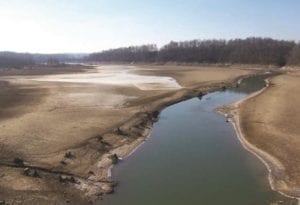
Some invertebrate groups may be affected by water regime. Zooplankton community composition and density are unlikely to be affected directly by changes in water levels. Direct effects are limited to flushing resulting from shortened water retention time. Indirectly, increases in water level may be associated with higher turbidity, which may shift the zooplankton community structure toward rotifers (section 5.7.3). Benthic invertebrates also are discouraged by water-level fluctuations, which cause a reduction in species diversity and abundance in nearshore invertebrate communities (Brauns et al. 2008). Most species have little ability to retreat with lowering water levels and, therefore, become stranded in substrates and desiccate. Species able to migrate with the changing water level (e.g., chironomids) or independent of the substrate (e.g., mobile benthos) may increase in abundance and representation. Water-level changes in shallow, gently sloping reservoirs likely affect more benthic organisms per unit of depth change than such changes do in steep-sided reservoirs.
Water-level fluctuations affect various aspects of fish ecology (Zohary and Strovsky 2011). Effects on fish spawning include limiting or expanding availability of suitable spawning habitat, increasing egg mortality by stranding eggs, forcing adult fish to abandon nests, constraining fish spawning to less favorable areas, and exposing eggs to increased predation. Water-level fluctuations often change food availability as they may force changes in feeding habits of fish and change predator–prey relationships, frequently by increasing piscivory during drawdowns. As is the case for invertebrates, drawdowns may force small or juvenile fish to move out of the nearshore region, exposing them to pelagic predation. Changes in food availability and trophic interactions can lead to changes in community composition. Fluctuations in population densities in many reservoir fish species have been linked to water-level fluctuations (more below).
7.4 Water Regime Management
Water regime management in reservoirs traditionally has focused on managing storage, which indirectly controls retention time. In fact, the goal of many reservoirs is to alter retention time to rearrange and smooth the annual discharge cycle by holding water during periods of high flow and releasing it during periods of low flow. As a result, there is a reduced seasonality in the river below the reservoir (Pegg et al. 2003). The dynamic nature of water regime in reservoirs and diversity of reservoir purposes make it difficult to develop generalized water regime management practices. However, there are general principles common to water regime management.
7.4.1 Monitoring Program
Long-term daily water-level records are often available online from the reservoir controlling authority or can be requested. For example, daily records for many reservoirs managed by the U.S. Army Corps of Engineers (USACE) are available online (USACE 2016). If records are not already available, they can be monitored by placing on-site a long-term water-level logger. Loggers often record other variables along with water level (e.g., water temperature). These loggers are available from various companies (e.g., HOBO, Bourne, Massachusetts; YSI, Yellow Springs, Ohio). Also available are off-the-shelf telecommunications options that include radio, telephone, and cell phone (e.g., Campbell Scientific, Logan, Utah; Bentek Systems, Calgary, Alberta). Systems can be programmed to send alarms or report site conditions by calling out to computers and phones. Real-time data can also be exported for further processing by spreadsheets or data analysis programs.
7.4.2 Timing of Flood
7.4.2.1 High water in spawning-growing season of fish
Water-level manipulation has been recognized as a useful tool for managing fish populations. Raising the water level above summer pool creates cover and a favorable environment for shoreline-dwelling fish (Keith 1975; Martin et al. 1981). A high water level during the spawning and growing seasons generally increases the abundance of age-0 fish of various species (Aggus and Elliott 1975; Shirley and Andrews 1977; Miranda et al. 1984; Mitzner 1991; Kahl et al. 2008). If the dam has the infrastructure needed to control water discharges, the management of water levels provides one of the most cost-effective means of managing a fish community. Depending on the species, strong year classes may not be needed every year to maintain a healthy fish population. The effects, however, are not always sufficiently predictable with a comfortable degree of confidence.
Extent of spring water-level fluctuations did not significantly affect the density of juveniles in main-stem reservoirs of the Tennessee River (Miranda and Lowery 2007). These aging reservoirs are characterized by barren regulated zones where repeated annual flooding prevents the establishment of most perennial and annual plants, which usually require 2–3 years to re-establish. Unlike the wetlands in a floodplain, the regulated zone does not normally support plants that thrive or can readily re-establish after flooding. Thus, the benefits of flooding may manifest only after a drought that has allowed vegetation enough time to expand in the mudflats or during a flood that inundates vegetation at elevations above the regulated zone.
7.4.2.2 Low water in growing season
Drawdowns during the growing season (i.e., frost-free season) are often an integral component of the operation of reservoirs, especially those operated for flood control and irrigation. Water is released slowly prior to rainy periods to open up storage capacity to hold potential floods and to provide water for the irrigation season. Guide curves generally have some flexibility for accommodating slightly different water regimes, flexibility that is needed given the randomness in annual rainfall patterns. Less flexibility exists in reservoirs operated for purposes other than flood control or irrigation.
Herbaceous terrestrial plants that become established on suitable substrates after a drawdown during the growing season are beneficial. These plants provide spawning and nursery sites for many species of fish when inundated at the appropriate times (Figure 7.8). They also provide food and refuge for bacteria, zooplankton, benthos, fish, and birds; substrates for attached algae; and nutrients for aquatic primary production. Establishment of herbaceous terrestrial vegetation after drawdown is also important for erosion control, aesthetic purposes, and nutrient retention. When reflooded, areas with a vegetation cover are less apt to contribute to turbidity.
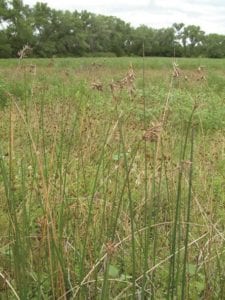
An earlier drawdown time in fall will result in a greater colonization and abundance of emergent species (Kadlec 1962; Casanova and Brock 2000). The longer the drawdown persists within the extent of the growing season, the greater the vegetation growth. Slow plant colonization and growth may occur in years of drought, when not enough rain wets the exposed regulated zone. Once the growing season ends, annual plant species may decay, although slowly because of low temperatures. If flooded, disintegration is accelerated. Thus, in many cases plant growth from the previous season may be best used in the current year if not flooded until just before fish spawning begins (Dagel and Miranda 2012). Depending on soils and geography, longer drawdowns caused by long-term droughts can encourage growth of woody vegetation that has longer durability under prolonged flooding.
According to Jenkins (1970) a drawdown during the growing season is potentially the most effective management tool for the reservoir biologist. Large drawdowns during the growing season can be used to restructure fish assemblages, although conflicts with other reservoir uses may occur (Keith 1975). Such conflict is minimal with flood control functions, so a drawdown is most applicable in flood control reservoirs. Based primarily on experience in the southeastern USA, Keith (1975) summarized the effects of a fall drawdown on forage populations. Predation reduces populations of overabundant forage fish when they are forced from cover in shallow water and concentrated in open water. Enhanced predator–prey interactions may increase predator growth rates. However, early summer drawdown can lead to year-class failures of some fish species, although responses to refilling the following year may more than compensate for current year inadequacies. Effects of drawdown on fish populations are frequently temporary, so the drawdown may need to be repeated every few years.
7.4.2.3 Winter drawdown
Lowering the water level in the winter exposes the sediment to both freezing and loss of water. Effects of winter drawdowns probably are most severe on aquatic macrophytes because prolonged exposure to freezing temperatures can be fatal (Cooke 1980). Thus, drawdowns can be used as a tool to control undesirable plants (section 11.5.2), although some nuisance plants are resistant to or are stimulated by the drawdown (Cooke 1980). Winter drawdowns also have been identified as a tool for reducing densities of zebra mussel (Dreissena polymorpha), although not total elimination (Grazio and Montz 2002). A negative effect of winter drawdowns is overall benthos reduction through exposure and freezing, which reduces the potential for high production in the following spring and early summer because of the time it takes to recolonize newly flooded substrates.
Warmwater fishes are more susceptible to entrainment and discharge from impoundments in winter than in other seasons because they are less active (Layzer et al. 1989). In reservoirs with extensive and rapid drawdowns in winter, mortality of fish can be reduced by limiting the rate and extent of drawdown. Survival of eggs or juveniles hatched in fall may be significantly reduced by fall and winter drawdown, as a result of stranding or loss of habitat. Development of eggs and fry is slow in cool water; consequently, their vulnerability to potentially adverse conditions is prolonged. The maintenance of stable water levels until juvenile fish are able to escape receding water levels is essential. If water levels must be lowered in late winter, it is best to lower them slowly. Additional benefits of winter drawdowns are that they may provide an opportunity to repair and improve fish habitat, docks, and other structures. Moreover, loose, flocculent organic sediment can become consolidated after drawdowns, potentially solidifying sediment and reducing turbidity.
7.4.3 Periodicity
7.4.3.1 Variability in timing
Varying water regimes have dissimilar effects on different fish species (Miranda and Lowery 2007). Therefore, a diversity of water regimes, including years with extreme low and years with extreme high water levels, rather than a rigid guide curve repeated annually, is likely most beneficial to the long-term permanence of diverse fish assemblages. Flooding within reservoirs is often highly engineered, with inflexible guide curves that allow only limited annual variation. Steady annual fluctuation patterns produce regulated zones devoid of vegetation and consisting primarily of mudflats of limited ecological value to most fish. Maintenance of water levels within the margins stipulated by the narrow range of a guide curve forces operational drawdown and flooding that adversely affect nearshore spawners. Operational flexibility to produce diverse water-regime patterns may be found in reservoir cascades such as those in the Columbia, Tennessee, and Missouri rivers (Hesse and Mestl 1993; Zagona et al. 2001). In developing water management plans, regulatory agencies may consider incorporating managed randomness into guide curves.
7.4.3.2 Extended flood
For some species year-class strength can be influenced more by survival after spawning than by spawning success (Martin et al. 1981; Miranda et al. 1984). Survival may be improved by maintaining high water levels for as long as possible after spawn- ing or at least until juveniles have reached some milestone (e.g., a certain length, a shift in diet, a change in habitat) that would increase the chances of recruitment into the next life-history phase. This is particularly true if lush vegetation is present in the reg- ulated zone. The provision of high water during summer is often restricted by peak demands for water usage and the need to begin reducing volume before the upcoming wet season. Thus, opportunities for enhancing recruitment of juveniles by maintaining high water in summer and fall until low water temperature reduces fish activity are generally limited. However, water management agencies are more likely to entertain such requests if they come spaced out every few years.
7.4.3.3 Long drawdowns and floods
Long drawdowns are more effective than short ones. To have a meaningful effect, according to Ploskey (1986) drawdowns should last several months during the growing season and substantially reduce the surface area to expose all or a large fraction of the regulated zone. Such drawdowns would allow for rejuvenation of moist-soil and terrestrial vegetation along nearshore areas and concentrate fish to facilitate predation and energy transfer, potentially enhancing growth and condition of all fish species. Similarly, Ploskey (1986) suggested that floods should be large enough to inundate terrestrial vegetation for several weeks during key reproduction and development periods. Generally, sporadic large and long drawdowns or floods are more effective than frequent ones in altering and biotic assemblages.
In reservoirs with extensive drawdowns, some embayments and inlets can be prevented from complete dewatering by the construction of submerged barriers across their mouths, which will help retain a shallow depth of water in them. Nevertheless, such barriers may become navigation hazards at some depth ranges. Alternatively, excavated depressions (section 9.3.3) also can hold back water in pools during drawdown.
Excessively long drawdowns can be detrimental to fisheries. Multiple sequential years of low water can limit use of boats, fishing effort, catch rates, and fishery harvest (Chizinski et al. 2014). Increased feeding activity and growth by piscivores has been reported during and immediately after reservoir drawdowns (reviewed by Ploskey 1983). However, following extended drawdown, and after an initial growth burst, growth of piscivores may diminish as prey densities are depleted.
7.4.4 Rate
7.4.4.1 Slow drawdowns
In general, slower drawdowns produce better conditions for a wide variety of plants, benthic invertebrates, and juvenile fish species. For plants, slow drawdowns allow the development of a shoreline zonation with different stages of plant growth; rapid drawdown tends to provide a wide homogenous area with lower diversity. For benthic invertebrates, slow drawdowns allow downward migration (Aroviita and Hämäläinen 2008); for benthic invertebrates and for fish rapid drawdown tends to increase stranding in substrate or isolated pools. In an Illinois reservoir, hatching success of largemouth bass was disrupted during rapid water-level rises and drops (Kohler et al. 1993); peak hatching success occurred when water levels were relatively stable. Gently rising water levels may be beneficial to many reservoir fish species if they evolved as floodplain species benefitting from rising water levels during the spawning period. Slow rises may produce a moving littoral within the reservoir as described for floodplains by the flood-pulse concept of Junk et al. (1989).
Rapid water-level drawdowns also can reduce the quality of shoreline habitats. Bank failures due to sudden drawdown often occur in slopes composed of clay materials, in which the excess pore water pressures do not have enough time to dissipate, thereby reducing the overall shear strength of the clay materials (Abramson et al. 2002). If the water level against the slope face is suddenly drawn down, the stabilizing pressure is removed quickly, creating an unbalanced condition. Thus, the banks may lose strength and stability, and segments may slide down into the reservoir reducing, depth and slope and homogenizing the bank.
Quick fluctuations of water levels are common in some reservoirs (Kennedy et al. 2002). Some of these fluctuations are innate to the reservoir’s purpose, such as hydropower reservoirs that experience small diel water-level fluctuations because of their power generation objective. Other reservoirs, such as those designed for flood control, experience fluctuations that may last a few months prompted by the need to increase discharge in anticipation of intense precipitation events, followed by quick rises as rainfall is stored. These quick fluctuations are less common in storage reservoirs, which are driven by the necessity to manage water level within a narrow-bounded guide curve. In reservoirs of the Tennessee River, quick spring fluctuations were more relevant to fish than spring water level (Miranda and Lowery 2007).
7.4.4.2 Long-term view
Long term, water-level management may produce more benefits if focused on producing a year with exceptional water-level conditions every few years than trying to provide acceptable water levels every year. A high water level only every 4–5 years would allow enough time for development of a lush vegetation community along shores and floodplains in the intervening years, whereas flooding yearly may not allow the plant community to develop. Even worse, high water levels that come too frequently may expand the width of the mudflats ring and worsen littoral habitat. Moreover, many fish species that inhabit reservoirs have developed life-history strategies that enable them to exploit periodic increases in resources, resulting in episodically strong year classes, sometimes described as cycles.
7.4.5 Vegetation Protection and Establishment
Where substrate conditions and other factors are suitable during drawdown, natural regeneration will take place from the existing seed bank or from seed blown in from surrounding upland areas. However, the shores on reservoirs often can remain bare or with patchy vegetation because of unfavorable environmental conditions. In these situations, it may be desirable to establish vegetation by artificial means (section 11.6). Conversely, excessively high and prolonged water levels kill trees and other terrestrial plants. Therefore, while high water levels inundate vegetation and that benefits fish, recurrent flooding can eliminate the vegetation.
7.4.6 Enhanced Aesthetic Value
Aesthetic value is not a major emphasis because most reservoirs were constructed for pragmatic applications such as flood control or hydropower applications. The water-level fluctuations associated with these applications prevent the growth of vegetation, create a ring of barren shoreline, and are therefore in direct conflict with aesthetics (section 7.3.1). Revegetation of this zone is possible and has been implemented (section 11.6). However, the vegetation does not last long (usually until the following flood), and recurrent plantings are necessary.
Aesthetics is a major concern in some reservoirs, or over time aesthetics might have evolved into a concern as economic and environmental values shift. In these reservoirs, options for preserving aesthetic value include limiting the magnitude of the drawdown as well as restricting the timing of the drawdown to seasons with reduced visitation. These changes are likely to conflict with the original objective of the reservoir. A study of Tennessee Valley Authority reservoirs revealed that large drawdowns, earlier in the summer and through the fall, decreased recreation suitability both through reduction of aesthetic quality and reduction of opportunity capacity (Cordell and Bergstrom 1993). These authors considered the effects on visitation under various alternative water-level management scenarios. For their study reservoirs, they estimated that gains in the economic value of recreation were greater than the losses in power generation. Results from the study eventually led to changes in the operating schedule to balance aesthetic values, recreation, and power generation.
7.4.7 Drought-Related Problems and Opportunities
Become a Contributing Sponsor
Become a part of projects that need your support.

